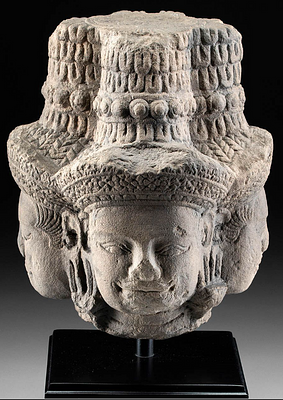Veracruz Stone Ball Game Yoke w/ Birds of Prey
About Seller
686 S Taylor Ave, Ste 106
Louisville, CO 80027
United States
Selling antiquities, ancient and ethnographic art online since 1993, Artemis Gallery specializes in Classical Antiquities (Egyptian, Greek, Roman, Near Eastern), Asian, Pre-Columbian, African / Tribal / Oceanographic art. Our extensive inventory includes pottery, stone, metal, wood, glass and textil...Read more
Two ways to bid:
- Leave a max absentee bid and the platform will bid on your behalf up to your maximum bid during the live auction.
- Bid live during the auction and your bids will be submitted real-time to the auctioneer.
Bid Increments
| Price | Bid Increment |
|---|---|
| $0 | $25 |
| $300 | $50 |
| $1,000 | $100 |
| $2,000 | $250 |
| $5,000 | $500 |
| $10,000 | $1,000 |
| $20,000 | $2,500 |
| $50,000 | $5,000 |
| $100,000 | $10,000 |
| $200,000 | $20,000 |
About Auction
Jun 29, 2023
Artemis Fine Arts info@artemisgallery.com
- Lot Description
Pre-Columbian, Gulf Coast of Mexico, Veracruz (Vera Cruz), ca. 550 to 900 CE. A hand-carved stone ball game yoke exhibiting delicate, faint hues of green, gray, cream, periwinkle, and tan. The front of the U-shaped accessory features a pair of raptorial birds in confrontation, their beaks and furrowed brows touching one another, while the exterior of each arm bears either 2 or 3 large excised slots meant to accommodate form-fitting inlays of shell or stone. This yoke is far too cumbersome and heavy to have been used during active play; instead wooden yokes or belts comprised of basketry were probably worn as they were far more practical. An impressive ceremonial yoke, beautifully carved and presenting rich iconography. Size: 14.6" L x 12.25" W x 3.875" H (37.1 cm x 31.1 cm x 9.8 cm); 10.6" H (26.9 cm) on included custom stand.
The Pre-Columbian ballgame originated in the first millennium BCE, most likely in the Valley of Mexico, and was regarded as not merely an athletic activity but rather as a ceremonial means of controlling or predicting the future. The ancients of Mesoamerica played ballgames in a sacred ballcourt space. Some cultures expected players to dedicate themselves to practicing the game and preparing for matches; however, other cultures forced war captives to play the game and sacrificed the losing team. Another custom involved using the possessions of onlookers as prizes for the victorious team.
Provenance: private Hawaii collection, acquired 2000 to 2010; ex-Earl Stendahl, Los Angeles, California, USA, acquired in the 1950s to 1960s
All items legal to buy/sell under U.S. Statute covering cultural patrimony Code 2600, CHAPTER 14, and are guaranteed to be as described or your money back.
A Certificate of Authenticity will accompany all winning bids.
We ship worldwide and handle all shipping in-house for your convenience.
#179862Condition
Appears to have been professionally repaired with light restoration and adhesive residue along new material and break lines; all done very well and look similar to natural striations in stone. Heavy polishing to 3 faces of stone to show original stone color. Expected nicks and abrasions to polished and unpolished areas, with chips to peripheries and losses to inlays, and surface roughness on unpolished areas, otherwise in great condition. Great surface smoothness across polished areas. Previous inventory label along inside curve.
- Shipping Info
-
All shipping is handled in-house for your convenience. Your invoice from Artemis Gallery will include shipping calculation instructions. If in doubt, please inquire BEFORE bidding for estimated shipping costs for individual items.
-
- Buyer's Premium



 EUR
EUR CAD
CAD AUD
AUD GBP
GBP MXN
MXN HKD
HKD CNY
CNY MYR
MYR SEK
SEK SGD
SGD CHF
CHF THB
THB















